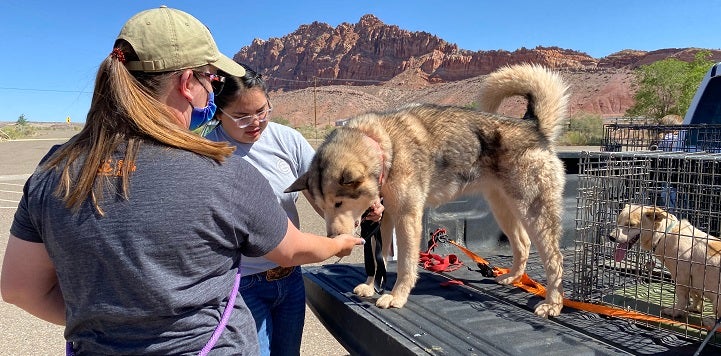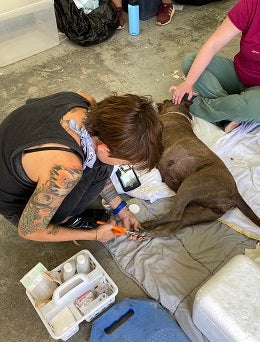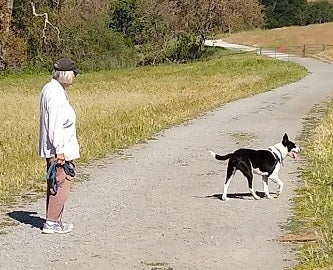
Building Bridges on the Navajo Nation
The challenges in rural America are vastly different from what we see in many cities. The distance between people and services, or the complete lack of services, can be particularly challenging. The challenges faced by Indigenous peoples living on rural reservations are often similar to other rural areas, but in the Navajo Nation they are amplified.
One of the closest reservations to Best Friends Animal Sanctuary in Southern Utah, the vast and sprawling Navajo Nation (or Diné Bikéyah) spreads across roughly 27,000 square miles of land in Arizona, New Mexico and Utah. For comparison, that’s slightly more than the state of West Virginia.
Drive through the area and you’ll likely be struck by how harsh the landscape appears, yet this land sustains more than 173,000 people (per the 2010 census). And where there are people, there are a variety of animal companions. In addition to keeping livestock, residents of the 110 communities (or chapters) strewn across this massive expanse are allowed to have up to four dogs, two if they live in the rentals managed by the Navajo Housing Authority.
With a mere six animal control officers serving the entire reservation, however, those limits are impossible to enforce. In fact, Navajo Nation animal control manager Kevin Gleason estimates that there are 250,000 dogs on the reservation. No word on how many cats call the area home, although there are far fewer compared to dogs.
That all adds up to a lot of people and pets needing access to basic resources like food, clean water and health care. Unfortunately, those things are not so easy to come by.
If you have limited resources, it's like, ‘Do I feed myself and my kids or do I feed these two litters of puppies?’ No one should have to make such a choice.
Collaborating to Overcome Unique Challenges
By some estimates, 35% of homes on the Navajo Nation have no running water. There are only 13 full-service grocery stores in the entire 27,000 square miles, so running out to pick up a bag of dog food is no simple errand. And access to regular veterinary care? There are only a handful of veterinarians practicing on the reservation, a few of whom provide occasional mobile services—though never enough to meet the need. Even low-cost services can be out of reach for a population challenged by a very high unemployment rate and low household income.
“In the face of such challenges, the resources provided by outside agencies who regularly hold spay/neuter clinics in various communities on the Navajo Nation are invaluable,” says Alex Allison, project manager and founder of The Parker Project, founded in 2018 to combat pet overpopulation by providing high quality, high-volume spay/neuter and medical services to underserved communities.

In addition to organizations like Soul Dog Rescue—which operates throughout the four corners region—and Animal Balance—which does both national and international work—the Parker Project collaborates with multiple agencies to provide a packed calendar of spay/neuter events. By working with such groups as Rez Dawg Rescue, Underdog Rescue of AZ, Tuba City Humane Society, the Navajo Nation Veterinary Program, High Country Humane and Rural Area Veterinary Services, the Parker Project is able to provide services to the Navajo Nation practically every weekend of the year.
“These communities need more assistance than a spay/neuter clinic once a year,” Alex says. “With this level of involvement, we can provide regular follow-up, give puppies their booster shots and offer more long-term treatment for complex situations. We also use a mobile surgery unit that allows us to reach everyone who needs assistance, including the elderly woman with 30 dogs whose homestead is on top of a mountain.”
“These are people who don't have a car or the money for gas to drive a couple of hours to the few resources available,” says Michelle Weaver, director of sanctuary outreach and animal engagement at Best Friends, which recently joined the list of organizations working with the Parker Project. Best Friends has also provided the organization with grant money to support its events.
“And they desperately need the help because their dogs and cats keep having all these litters,” Michelle adds. “If you have limited resources, it's like, ‘Do I feed myself and my kids or do I feed these two litters of puppies?’ No one should have to make such a choice.”
Transport and Rescue Play a Vital Role
In addition to spay/neuter and medical support, shelters and rescue groups can also help Indigenous communities all over the country by transporting out animals in need of homes.
“Health issues are always a challenge for groups wanting to transport animals from an under-resourced area,” says Michelle. “We do see quite a bit of distemper and parvo, especially with puppies, and with large groups of dogs running around with each other, there are some issues with transmissible venereal tumors. Tick-borne diseases are also prevalent.”
If anything, however, that underscores the need for robust, consistent support. Providing vaccines can cut down on parvo and distemper; offering flea and tick treatments helps prevent serious issues; and spaying and neutering decreases the spread of sexually transmissible diseases. The positive impacts can snowball from there, as fewer mouths to feed means less stress to find food and health care, and fewer dogs overall means reduced issues with public safety.
As far as behavioral issues go, as Best Friends’ Navajo Nation program specialist Keith Slim-Tolagai likes to say: “Rez dogs are the best dogs.” Indeed, the dogs on the Navajo Nation have lots of exposure to multiple people, children and other animals, including livestock. While they may be under socialized to leashes or car rides, it does not take long for them to come around.
“Most are wonderful dogs who learn quickly and are super friendly with others,” Michelle says.

Much like dogs in shelters across the country, you won’t find a lot of purebreds roaming the reservation. Instead, you’ll find dogs like Riley, who ended up at our sanctuary this past spring. A DNA test showed him to be 24% Border Collie, 23% Pembroke Welsh Corgi, 18% McNab, 8% Collie, 15% American Staffordshire Terrier, 6% Mexican street dog, 2% giant Schnauzer, 2% English Springer Spaniel and 2% Lapponian Herder. To his new people, however, Riley is just an adorable dog who won their hearts right away.
Building Rapport and Trust
None of this work is possible without first establishing a foundation of trust.
“You have to earn their respect,” Alex says. “You can’t just swoop in like you’re saving the day and then disappear for months. It’s critical that you involve yourself with as many people as possible in the communities, including the animal control officers and tribal councils. And always practice safe veterinary medicine to get welcomed back.”
Though Best Friends has long provided some spay/neuter, vaccinations and supplies to the populations on reservation lands located close to our sanctuary in southern Utah—as well as accepting animals in from those areas for adoption—we have not been deeply invested in those communities. That changed, however, when Keith was hired in January of this year to work on the Navajo Nation project. Keith grew up on the Navajo Nation in Piñon, Arizona, and recently moved back after being away for nearly 30 years.
“I wanted to hire someone who was familiar with the community and understood their needs,” Michelle says. “By living there, he also comes to know the challenges they face daily, and that helps us fine-tune what we are offering.”
Alex agrees that it’s vital to understand the unique challenges the population struggles with. For instance, she can’t always send people home with refrigerated meds because they might not have a fridge in the first place due to a lack of electricity. And although many people keep their dogs tied in the yard, making them vulnerable to being impregnated or attacked by roaming dog packs, she can’t tell people to keep their pets safe indoors.
“It’s a cultural issue. You must navigate these communities and respectfully help them help their animals. It’s not about trying to change their culture,” Alex says.
Despite—or maybe because of—all these challenges, Alex and Michelle have come to really love working on the Navajo Nation.
“It's not that people don't care about their animals; they care very deeply,” Michelle says. “Animals are deeply important to them culturally. I’ve met so many incredibly passionate, wonderful people within this community who want to take the best possible care of their animals. They just need to know where to get the services. We want to give them that.”
“All of this work is about giving people a chance to help the animals they love, to give those animals what they deserve,” Alex adds. “It’s making sure those on the Navajo Nation get a chance to treat these beloved family members the way anyone should be able to treat their pets, no matter where they live.”
If you want to hear more from Michelle Weaver or Keith Slim-Tolagai about this topic, you can listen to this week’s podcast here. For previous content about helping underserved communities, check out:
Serving the Underserved in Rural America podcast
Saving Lives in Rural Indiana podcast
Finding Pathways to Success for Rural Shelters program spotlight
Transports Drive Lifesaving for Rural Shelters program spotlight
Liz Finch
Senior Writer
Best Friends Network
If you enjoyed this program spotlight, you can find our complete catalog of spotlights here.